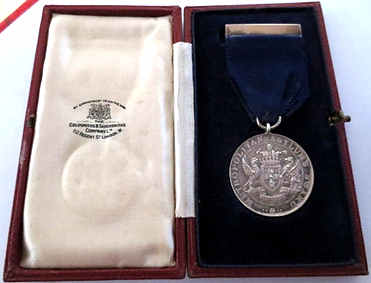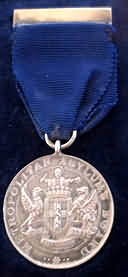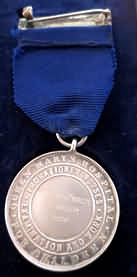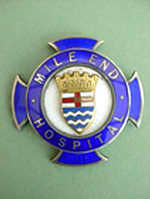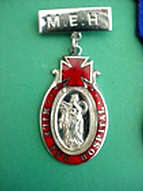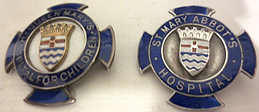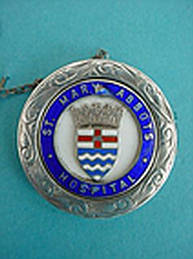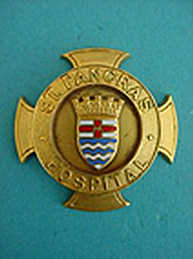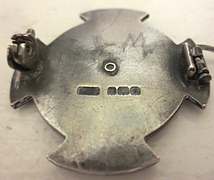|
Collecting Nursing History 36 Metropolitan Asylums Board Medals and London County Council Hospital Badges Sarah Rogers. |
 |
Please Note: Whilst every care is taken in checking promoted links, we cannot accept responsibility for your use of third party web links. | |||||||||||||
This article explores the types of nurses' badges that were issued by hospitals run by the Metropolitan Asylums Board (MAB) and its successor body, London County Council (LCC). LCC Hospitals' nurses' badges were issued by LCC from 1930-1948, the design of which was taken from the LCC coat of arms, which had been granted in 1914. In London, the MAB, which had been set up to care for London's Poor Sick following the Metropolitan Poor Act of 1867, was abolished in 1930 following the 1929 Local Government Act. This Act abolished the Poor Law Unions and the Boards of Guardians who ran the workhouse infirmaries, and all these institutions' transferred to Local Authority control. In London, the Central Public Health Committee of LCC ran these hospitals from 1930, until 5 July 1948 when the newly formed NHS took over running them. Many hospitals then stopped issuing the standard LCC badges, as shown below, and introduced their own designs. Metropolitan Asylums Board; 1867 - 1930.
Fig 6 - Above: Silver MAB Medal awarded to Kathleen Pannett in 1929, the training hospital presented this to the probationer nurse who gained the highest marks in her nursing exams and work. There were 23 MAB training schools for nurses, which were made up of; (19) One Childrens Hospital Five Mental Health Hospitals' Seven TB Hospitals' Ten Fever Hospitals' From researching historical nursing journals, there are 19 reported instances of medals being presented to probationers from hospitals within the MAB group.(7) The medals were; gold, silver and bronze, and were awarded across the MAB group, usually only to fever hospital nurses, but later on also to nurses from four other specialities; Infectious Hospitals' service, Tuberculosis Service, Mental Health and Childrens' Service.(8) From 1914-1925 the three categories of medal were awarded to nurses from fever hospitals only, but in 1926 three children's nurses received silver medals, and in 1929 two children's nurses received silver medals, along with one mental health nurse.(9) In 1926 one medal of each colour was awarded to nurses in each of the four categories of training hospital; general nursing is not mentioned. The bias towards fever nurses winning the medals may be because nearly 50% of the MAB hospitals were fever hospitals, and until 1929 Mental Health Nurses were excluded from competing in the Medal examinations.(10) The medals were awarded to the nurses whose names had been put forward by the Matron and Medical Superintendent from each MAB hospital, who then competed for a medal in a medal examination.(12) Each MAB hospital chose '...Not more than the three best nurses...', based on their clinical work and exam success in the tri-annual State final or professional nursing exams of their speciality. The selected nurses were then entered into the 'medal' examination, which was in the appropriate speciality for their training hospital; infectious hospitals service, medical tuberculosis service, children's hospitals service, and surgical tuberculosis service.(13) There was no medal for; 'Mental Hospitals Service -No medal is awarded', although the Mental Hospitals committee had asked Dr Sherlock, the Chief Medical Officer to inquire into the implementation of a medal for this service.(14) In order to determine which of the nominated nurses' should receive medals, they were all examined by a Medical Officer, and a Matron; who might be from their own hospital or elsewhere. The nurses' with the three highest marks were given gold, silver, and bronze, however should two nurses tie with the same marks for second place, two silver medals were awarded rather than a silver and bronze. From 1928 two outside examiners were appointed annually, in order to standardise this practise and remove any bias to a particular nurse, and it was also resolved to disallow any nurse who had taken her state finals of professional exams more than once, from being entered into a medal exam, as again the nurse would have extra examination experience, giving them an unfair advantage.(15) There is little information about what badges were issued and what date they were issued from; there do not appear to be many MAB medals in; the one below is a silver medal, but what I do not know is whether there are any examples in existence of gold and bronze medals also. From this research it is clear that the medals were definitely awarded between 1914 and 1929; but not all awards are mentioned in the press, the silver medal to Kathleen Pannett is not mentioned. What is clear is that these medals are rare; were awarded for a 15 year period from 1914 -1929; and at least from the 1920's following the tri-annual pattern of General Nursing Council exams, and for the first few years only awarded to probationer nurses from fever hospitals.(16) From 1929 the medals would appear to have been awarded to nurses from all specialities. Voluntary hospitals such as St Thomas' Hospital gave prizes, their records' show Gold, Silver and Bronze medallists for 1939; what is not clear is if it was a 'paper' award, or if there was a physical prize or medal.(5) At the London Hospital in the 1980's, student nurses' were awarded, Distinctions and Merits for Intermediate and Hospital Finals, the latter was recorded on our Hospital Certificates, but no extra badge or medal was awarded.
Fig7 & 8; MAB medal awarded to Kathleen J Pannett in October 1929. MAB Silver medal for St Mary Abbott's awarded to Kathleen Joan Pannett. Again, there is very little information in the hospital records for Kathleen Joan Pannett; however, her more unusual surname and two first names helped me research her. There is one shared line with her name on in the Staff register for St Mary Abbott's; her name had been inserted into the same line as another's. Kathleen also seems to have been called Joan, as she is recorded under her middle name only; her date of birth is recorded as 14th may 1908 and she commenced her training on 1st October 1926, so appears to have received this Silver Medal at the end of three years training.(3) Kathleen was recorded in the Sick Childrens Nurses register as nurse number 1632, and living in Horsham, Sussex.(17) Kathleen was probably born in Horsham in 1908, and in 1932, she is found in Islington on the electoral roll. Kathleen appears to have married in 1938 Francis B Hobson, dying in 1989 on the Isle of Wight; this is un-corroborated and original sources would need to be consulted. In January 1938, her registration fee is unpaid and her name was removed from the register; which fits with her marriage.(18) Her sister Violet Mary Pannett was also in St Mary Abbott's Hospital register- she started her training aged 26 on1st December 1926, but did not complete her training; she left on 11 February 1927. (3)
London County Council Hospital Badges or LCC badges (1930 - 1948),
as they are often known, generally have no nurses' names engraved on
the reverse.
Fig1 and 2. L: R; LCC style Mile End Hospital badge, and Mile End Hospital badge post 1948. There are approximately 90 such hospitals who became run by LCC, but they may not all be Training Hospitals and therefore may not have issued badges to nurses on qualification ; (1) Archway (formerly Holborn and Finsbury Hospital) Bethnal Green Dulwich (Formerly Southwark Hospital) Fulham Hackney 1 & 11 Hammersmith (1and 11 now amalgamated) Highgate Lambeth (1 & 11 now amalgamated) Lewisham Mile End New End Norwood Children's Paddington (formerly Paddington Infirmary) Queen Mary's Hospital Sidcup St.Alfege's (1&11) St Andrew's (Poplar) St Benedict's St.Charles (formerly S.Marylebone Hospital) St Clements (formerly City of London Union Institution) St Francis (formerly Constance Road Institution) St George in the East (Stepney) St Giles St James' St John's St Leonard's St Luke's St Mary Abbots (1 & 11) St Mary Islington St Matthew's (formerly the Holborn City Rd Institution) St Nicholas (formerly Plumstead & District Hospital) St Olaves (formerly Bermondsey and Rotherhithe Hospital) St Pancras (formerly St Pancras South Hospital) St Peter's (Whitechapel Hospital) St Stephens (Westminster) Tuberculosis Hospitals and Sanatoria; Colindale Grove Park Heatherwood High Wood-For Children King George V Sanatorium (Godalming) Millfield (Littlehampton) Pinewood Sanatorium St Georges Home St Luke's (Lowestoft) Goldie Leigh Princess Marys (for Rehabilitation) (Margate) St Anne's Home (Herne Bay) The Downs (Sutton Surrey) White Oak (Swanley, Kent) Hospitals for Sane Epileptics; St David's (formerly Edmonton Epileptic Colony) St Faith's (Brentwood) Hospitals for Ophthalmia Neonatorum; St Margaret's Hospitals for VD Sheffield Street Thavies Inn Mental Hospitals (belonging to the LCC before 1930); Banstead Hospital Bexley Hospital Cane Hill Hospital Claybury Hospital Friern Hospital (formerly Colney Hatch Hospital) Horton Hospital Long Grove Hospital St Bernard's Hospital (formerly Hanwell Hospital) West Park St Ebba's Formerly Ewell Colony Maudsley Hospital The Manor (Epsom) Farmfield (Horley) South Side Home Leytonstone House Brunswick House Darenth Park Fountain Hospital Leavesden Hospital St Lawrence's Hospital (formerly Caterham Hospital) Tooting Bec Sutton Emergency Hospital From the Metropolitan Asylums Board; Brook Eastern Grove North Eastern Northern North Western Park The River Hospitals; 1. Joyce Green 2. Long Reach 3. Orchard South Eastern Southern; 1.Upper 2. Lower South Western Western Hospital for Sick Children; Queen Mary's (Carshalton) It is not known if all of these hospitals had the standard badge, which either had a white or silver background:
Fig 3. Lt & Rt; Queen Mary's Hospital for children with white enamel background and St Mary Abbot's Hospital with silver background. Occasionally badges are found which are gold, silver and a different shape, thought to possibly be prize medals; a search of historical nursing journals revealed that gold and silver medals were awarded annually by London County Council to nurses who had taken the councils final examination for nurses in that year. For the three years that are documented in the nursing press nine gold and 38 silver medals are awarded; distinction certificates are also presented. In 1947, the highest marks were awarded to Miss Hortense Heidenfield from St Stephens Hospital, Fulham who gained 721 marks out of 800.(11)
Fig 4 and 5, Copyright; Schools of Nursing/Backman. Having searched many staff records for these hospitals during the LCC period, they all seem very scanty in information about the probationers and their exams, unlike the bigger voluntary hospitals such as St Bartholomew's, St Thomas' and the London Hospital, which, where the records have survived do contain varying detail about examination results. St Mary Abbotts; Ruby Lucille Morgan.
Fig 9. Reverse of St Mary Abbott's LCC Badge with crudely engraved initials; R L M. The reverse of this LCC badge, for St Mary Abbott's revealed three tantalizing initials, which are crudely scratched on, 'R L M'. A complete long shot led me to find only one nurse with the same initials in the register for St Mary Abbott's Hospital. In common with other LCC hospitals' staff records, Ruby Lucille Morgan has only one line about her; she trained at the hospital from 1936 - September 4th 1939; she was intended for four years in training, but due to the outbreak of WW2, her training was shortened. A brief note beside her name in the register states 'Returned to Sutton'. This is presumed to be Sutton Hospital, Sutton, Surrey. There may be no way of ever establishing which of the MAB and LCC hospitals gave prize medals, as the generation of nurses who received them are dying and elderly. The only hope is either that some hospital records may show examination results and even mention exam prize medals, or that some of these nurses had children to whom they passed on such information through oral history References: 1. Peter Maleczek citing from 'London County Council Hospitals, A Retrospect.' 1949 on www.schools of nursing.co.uk. 2. The London Metropolitan Archives, St Mary Abbott's Nursing Register, H17/SMA/C/01/003, pg 65. 3. LMA/MAB/2446, Queen Mary's Hospital, Register of Staff, pg94.
4. www.ancestry.co.uk; FreeBMD. England & Wales, FreeBMD Birth
Index, 1837-1915; The National Archives, 1911 England Census, RG14,
Piece, 5247, 5. London Metropolitan Archives, H01/ST/NTS/C/11/002, pg; Final Results and Medal Awards 1939. 6. J. Meglaughlin, 'British Nursing Badges, An Illustrated Handbook', London, 1990.
7.
http://rcnarchive.rcn.org.uk, The British Journal of Nursing, June
11, 1921, pg 360; The BNJ, January 7th 1922, pg 10; The BNJ,
December 23rd 1922, pg 414; 8. http://rcnarchive.rcn.org.uk, The BNJ, January 1925, pg20.
9. http://rcnarchive.rcn.org.uk, The BNJ, June 11, 1921, pg 360; The
BNJ, January 7th 1922, pg 10; The BNJ, December 23rd 1922, pg 414;
The BNJ, June 9th 10. http://rcnarchive.rcn.org.uk, The BNJ, January 1925, pg20. 11. http://rcnarchive.rcn.org.uk, The BNJ, April 1935, pg 104; The BNJ, July 1946, pg 75; The BNJ, July 1948, pg's 80-81. 12. LMA, Metropolitan Asylums' Board Medical and Nursing Sub-Committee, Volume 111 1927-1930, MAB 0787, pg's31, 68. 13. LMA, MAB, 0787, pg 32. 14. LMA, MAB, 0787, pg 31.
15. LMA, MAB, 0787, pg 3, 68; State Finals were held for Sick
Children's and Fever Nursing, TB abd Mental Health specialities were
examined by their own 16. LMA, MAB, 0787, pg 15. 17. TNA, General Nursing Council Register, Sick Childrens Nurse supplement, DT10/195, pg 234. 18. TNA, General Nursing Council Register, Sick Childrens Nurse supplement, DT10/195, pg 234. 19. Dr. G. M. Ayers, 'England's First State Hospitals 1867-1930', Wellcome Institute of the History of Medicine, London, 1971, pg 151. Illustrations; 1-2, 4-5; Copyright Schools of Nursing/ Backman. 3, 6, 7-8, 9, Copyright; Private Collection. © Sarah Rogers 12/1/2014. |
SECTION
1 SECTION 2 |
||||||||||||||
| Home Schools Region Forum Collecting Galleries History Bibliography News Archive Contact |
